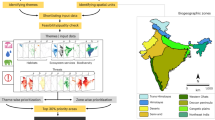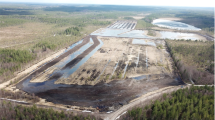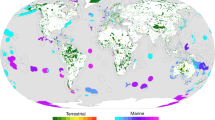Abstract
Understanding the scale, location and nature conservation values of the lands over which Indigenous Peoples exercise traditional rights is central to implementation of several global conservation and climate agreements. However, spatial information on Indigenous lands has never been aggregated globally. Here, using publicly available geospatial resources, we show that Indigenous Peoples manage or have tenure rights over at least ~38 million km2 in 87 countries or politically distinct areas on all inhabited continents. This represents over a quarter of the world’s land surface, and intersects about 40% of all terrestrial protected areas and ecologically intact landscapes (for example, boreal and tropical primary forests, savannas and marshes). Our results add to growing evidence that recognizing Indigenous Peoples’ rights to land, benefit sharing and institutions is essential to meeting local and global conservation goals. The geospatial analysis presented here indicates that collaborative partnerships involving conservation practitioners, Indigenous Peoples and governments would yield significant benefits for conservation of ecologically valuable landscapes, ecosystems and genes for future generations.
This is a preview of subscription content, access via your institution
Access options
Access Nature and 54 other Nature Portfolio journals
Get Nature+, our best-value online-access subscription
$29.99 / 30 days
cancel any time
Subscribe to this journal
Receive 12 digital issues and online access to articles
$119.00 per year
only $9.92 per issue
Buy this article
- Purchase on Springer Link
- Instant access to full article PDF
Prices may be subject to local taxes which are calculated during checkout




Images courtesy of the Integration and Application Network, University of Maryland Center for Environmental Science (ian.umces.edu/symbols/).
Similar content being viewed by others
References
Indigenous peoples. The World Bank http://www.worldbank.org/en/topic/indigenouspeoples (2017).
C169 − Indigenous and Tribal Peoples Convention, 1989 (No. 169) (International Labour Organisation,1989); http://www.ilo.org/dyn/normlex/en/f?p=NORMLEXPUB:12100:0::NO::P12100_ILO_CODE:C169
Berkes, F. Community-based conservation in a globalized world. Proc. Natl Acad. Sci. USA 104, 15188–15193 (2007).
Sobrevila, C. The Role of Indigenous Peoples in Biodiversity Conservation (World Bank, Washington, 2008).
Gilbert, J. Indigenous Peoples’ Land Rights under International Law (Brill, Leiden, 2016).
Stevens, S., Jaeger, T. & Broome, N. P. ICCAs and Overlapping Protected Areas: Fostering Conservation Synergies and Social Reconciliation (ICC Consortium, Teheran, 2016).
Veit, P. & Reytar, K. By the numbers: indigenous and community land rights. World Resources Institute http://www.wri.org/blog/2017/03/numbers-indigenous-and-community-land-rights (20 March 2017).
Bryan, J. Walking the line: participatory mapping, Indigenous rights, and neoliberalism. Geoforum 42, 40–50 (2011).
Gavin, M. C. et al. Defining biocultural approaches to conservation. Trends Ecol. Evol. 30, 140–145 (2015).
Forest Peoples Program. International Indigenous Forum on Biodiversity & Secretariat of the Convention on Biological Diversity. Local Biodiversity Outlooks – Summary and Conclusions (Forest Peoples Programme, Moreton-in-Marsh, 2016).
Schmeller, D., Henle, K., Loyau, A., Besnard, A. & Henry, P. Y. Bird-monitoring in Europe - a first overview of practices, motivations and aims. Nat. Conserv. 2, 41–57 (2012).
LandMark, global platform of indigenous and community lands. http://www.landmarkmap.org/ 2018.
UNEP-WCMC and IUCN. Protected Planet: The World Database on Protected Areas (UNEP-WCMC and IUCN, Cambridge, 2016).
Ellis, E. C. & Ramankutty, N. Putting people in the map: anthropogenic biomes of the world. Front. Ecol. Environ. 6, 439–447 (2008).
Venter, O. et al. Global terrestrial Human Footprint maps for 1993 and 2009. Sci. Data 3, sdata201667 (2016).
Convention on Biological Diversity. Decision Adopted by the Conference of the Parties to the Convention on Biological Diversity at its Tenth Meeting X/2. The Strategic Plan for Biodiversity 2011–2020 and the Aichi Biodiversity Targets (UNEP, 2010); https://www.cbd.int/doc/decisions/cop-10/cop-10-dec-02-en.pdf
Sustainable Development Goals (United Nations, 2015); https://www.un.org/sustainabledevelopment
Transforming our World: 2030 Agenda for Sustainable Development (United Nations, 2015); https://undocs.org/A/RES/70/1
Díaz, S. et al. The IPBES Conceptual Framework—connecting nature and people. Curr. Opin. Environ. Sustain. 14, 1–16 (2015).
Renwick, A. R. et al. Mapping Indigenous land management for threatened species conservation: an Australian case-study. PloS One 12, e0173876 (2017).
Dowie, M. Conservation Refugees: the Hundred-Year Conflict between Global Conservation and Native Peoples (MIT Press, London, 2011).
Watson, J. E. M. et al. Persistent disparities between recent rates of habitat conversion and protection and implications for future global conservation targets. Conserv. Lett. 9, 413–421 (2016).
Watson, J. E. M. et al. Catastrophic declines in wilderness areas undermine global environment targets. Curr. Biol. 26, 2929–2934 (2016).
Finer, M. et al. Future of oil and gas development in the western Amazon. Env. Res. Lett. 28, 024003 (2015).
Trosper, R. L. Northwest coast Indigenous institutions that supported resilience and sustainability. Ecol. Econ. 41, 329–344 (2002).
Simon, S. & Randalls, S. Resilience and the politics of multiplicity. Dialog. Human. Geog. 6, 45–49 (2016).
Norman, E. S. Standing up for inherent rights: the role of Indigenous-led activism in protecting sacred waters and ways of life. Soc. Nat. Res. 30, 537–553 (2017). (2017).
Brondizio, E. S. & Le Tourneau, F.-M. Environmental governance for all. Science 352, 1272–1273 (2016).
Mantyka-Pringle, C. S., Westman, C. N., Kythreotis, A. P. & Schindler, D. W. Honouring Indigenous treaty rights for climate justice. Nat. Clim. Change 5, 798–801 (2015).
Corrigan, C. J., Robinson, C., Burgess, N. D., Kingston, N. & Hockings, M. Global review of social indicators used in protected area management evaluation. Conserv. Lett. 11, e12397 (2017).
Kohler, F. & Brondizio, E. S. Considering the needs of Indigenous and local populations in conservation programs. Conserv. Biol. 31, 245–251 (2017).
Tengö, M. et al. Weaving knowledge systems in IPBES, CBD and beyond—lessons learned for sustainability. Curr. Opin. Environ. Sustain. 26–27, 17–25 (2017).
Armitage, D., de Loë, R. & Plummer, R. Environmental governance and its implications for conservation practice. Cons. Lett. 5, 245–255 (2012).
Convention on Biological Diversity. Akwé: Kon Voluntary Guidelines for the Conduct of Cultural, Environmental and Social Impact Assessment Regarding Developments Proposed to Take Place on, or Which Are Likely to Impact on, Sacred Sites and on Lands and Waters Traditionally Occupied or Used by Indigenous and Local Communities (Secretariat Of The Convention On Biological Diversity, Montreal, 2004).
Convention on Biological Diversity. Revised Draft of the Elements of an Ethical Code of Conduct to Ensure Respect for the Cultural and Intellectual Heritage of Indigenous and Local Communities: Note by the Executive Secretary UNEP/CBD/WG8J/6/4 (Secretariat of the Convention on Biological Diversity, Montreal, 2009).
Whakatane Mechanism (2018); http://whakatane-mechanism.org
Jonas, H. et al. Will OECMs increase recognition and support for ICCAs? PARKS 23, 2 (2017).
IUCN WCPA. Guidelines for Recognising and Reporting Other Effective Area-based Conservation Measures, Version 1. (IUCN: Gland, 2017).
Agnoletti, M. (ed.) The Conservation of Cultural Landscapes. (CABI: Wallingford, 2006). .
Wangpakapattanawong, P., Kavinchan, N., Vaidhayakarn, C., Schmidt-Vogt, D. & Elliott, S. Fallow to forest: applying Indigenous and scientific knowledge of swidden cultivation to tropical forest restoration. For. Ecol. Manag. 260, 1399–1406 (2010).
Vigilante, T. et al. Collaborative research on the ecology and management of the ‘Wulo’ Monsoon Rainforest in Wunambal Gaambera Country, North Kimberley, Australia. Land 6, 68 (2017).
Raymond, C. M. et al. Integrating local and scientific knowledge for environmental management. J. Env. Mgmt. 91, 1766–1777 (2010).
Tengö, M., Brondizio, E. S., Elmqvist, T., Malmer, P. & Spierenburg, M. Connecting diverse knowledge systems for enhanced ecosystem governance: the multiple evidence base approach. Ambio 43, 579–591 (2014).
Sangha, K. K. et al. An ecosystem services framework to evaluate Indigenous and local peoples’ connections with nature. Ecosys. Serv. 31, 111–125 (2018).
Leiper, I. et al. Quantifying current and potential contributions of Australian Indigenous Peoples to threatened species management. Cons. Biol. (in the press).
United Nations Department of Economic Affairs. State of the World’s Indigenous Peoples. (United Nations Publications: New York, 2009).
Global Administrative Areas (GADM) v2.8, http://gadm.org/version2 (2015).
Brooks, T. M. et al. Analysing biodiversity and conservation knowledge products to support regional environmental assessments. Sci. Data 3, 160007 (2016).
Venter, O. et al. Data from: Global terrestrial Human Footprint maps for 1993 and 2009. Dryad Digit. Repos. https://doi.org/10.5061/dryad.052q5.2 (2016).
Tucker, M. A. et al. Moving in the Anthropocene: global reductions in terrestrial mammalian movements. Science 359, 466–9 (2018).
Jones, K. R. et al. One-third of global protected land is under intense human pressure. Science 360, 788–791 (2018).
Ellis, E. C., Klein Goldewijk, K., Siebert, S., Lightman, D. & Ramankutty, N. Anthropogenic transformation of the biomes, 1700 to 2000. Glob. Ecol. Biogeog. 19, 589–606 (2010).
Ellis, E. C. Anthropogenic transformation of the terrestrial biosphere. Philos. Trans. R. Soc. Lond. A: Math. Phys. Eng. Sci. 369, 1010–1035 (2011).
Acknowledgements
We thank the thousands of people and government agencies who contribute to the World Database on Protected Areas (WDPA) that is jointly developed by UN Environment and IUCN and managed by UNEP-WCMC in Cambridge, UK. We also acknowledge the efforts of those involved in participatory mapping of Indigenous lands, particularly F. Dubretet and others involved in developing the LandMark global platform for Indigenous and Community Lands. Early advice on the research was provided by A. Parellada, L. García-Alix and G. Rose of the International Work Group for Indigenous Affairs and contributors to the World Parks Congress 2014 symposium on contributions to biodiversity conservation by the Indigenous Peoples and local communities of Africa: V. Courtois, H. Hunter-Xenie, A. Kothari, J. Morrison, G. Oviedo, J. Scott, B. Sithole, A. Tawake and L. Usongo. Additional national advice was kindly provided by R. Andreoli (New Caledonia), J. Ibanez (Philippines), N. Aldrin Mallari (Philippines), J. Scopélitis (New Caledonia), E. Stancioff (Dominica), V. Toral-Grande (Ecuador) and M. Tovar-Valencia (Mexico). J. Harrison and H. Bingham provided helpful comments on the final manuscript and L. Luck helped with illustrations.
Author information
Authors and Affiliations
Contributions
S.T.G. conceived the paper, drafted the initial text and analysed data. S.T.G., T.D., M.V.J., B.M., A.S. and I.L. located the maps and I.L. undertook the GIS analysis. J.E.F., K.K.Z., I.L. and H.G. analysed data. All 20 authors contributed ideas and finalized the text.
Corresponding author
Ethics declarations
Competing interests
The authors declare no competing interests.
Additional information
Publisher’s note: Springer Nature remains neutral with regard to jurisdictional claims in published maps and institutional affiliations.
Supplementary information
Supplementary Information
Supplementary Information
Rights and permissions
About this article
Cite this article
Garnett, S.T., Burgess, N.D., Fa, J.E. et al. A spatial overview of the global importance of Indigenous lands for conservation. Nat Sustain 1, 369–374 (2018). https://doi.org/10.1038/s41893-018-0100-6
Received:
Accepted:
Published:
Issue Date:
DOI: https://doi.org/10.1038/s41893-018-0100-6
This article is cited by
-
Piper agroforestry in the Indian Himalayas: indigenous peoples’ practices, policies and incentives
CABI Agriculture and Bioscience (2024)
-
Ecological research ‘in a good way’ means ethical and equitable relationships with Indigenous Peoples and Lands
Nature Ecology & Evolution (2024)
-
Contributions of human cultures to biodiversity and ecosystem conservation
Nature Ecology & Evolution (2024)
-
Mobile apps for 30×30 equity
Nature Sustainability (2024)
-
The principles of natural climate solutions
Nature Communications (2024)



